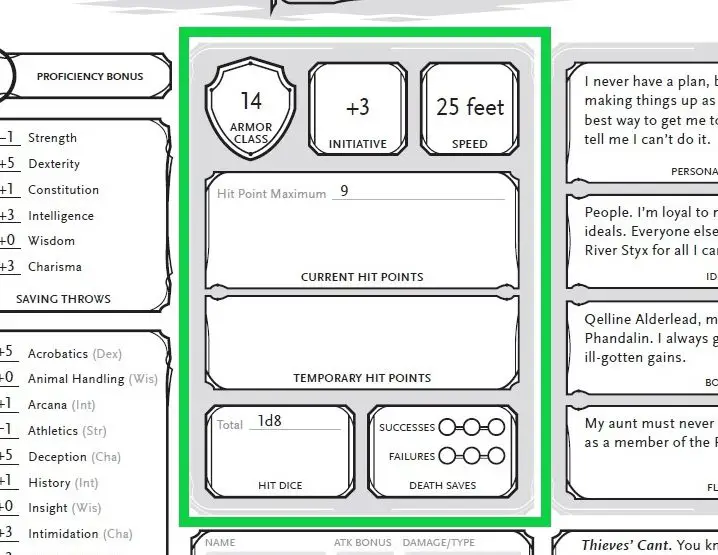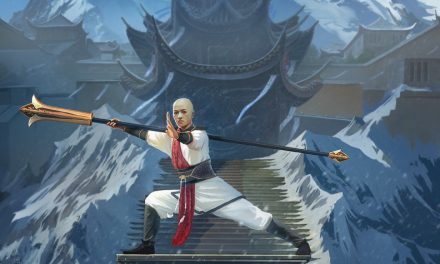One of the most important parts of any D&D session is combat.
Hit points, or HP, are an integral part of this as they determine how long you can fight and survive before succumbing to your wounds.
This week we’re going over temporary hit points. As the name implies, these are one-time use hit points that come in handy when you find yourself taking damage!
This is a mechanic that’s responsible for a fair amount of confusion among D&D players, so I’m hoping that this guide is thorough enough to clear up any of that confusion that you might be experiencing.
That said, let’s dive into how temporary hit points work in D&D 5e!
What Are Temporary Hit Points?
In Dungeons and Dragons, a player’s hit points represent their character’s ability to stay alive. Hit points are determined by the class the player chooses at creation time, as well as any bonuses that are given from items or spells.
Temporary hit points represent an increase in one’s hit point total for a limited amount of time. These are tracked separately from your character’s total health and are lost when your character takes damage, just like regular hit points.
Temporarily increasing the amount of damage that your character can take is a great way to survive an otherwise deadly encounter without having to spend precious resources on healing potions or spells. It also provides a tactical advantage in battle because enemies will need more hits to kill you!
Describing Temporary Hit Points
Thematically, temporary hit points could take any form that represents an increase in a character’s fortitude.
A martial character might be highly motivated following a commander’s speech or be more resilient due to sheer adrenaline.
A Divine caster like a Cleric or Druid might have a small protective aura around them. As they take damage, the aura gets smaller as the temporary hit points absorb some of the damage.
A Necromancer or Warlock might have a similar effect but with a bit of a darker twist to it. A shadowy aura of souls surrounds the character. As the character takes damage, the souls vanish with a faint wail of pain.
Whether temp HP is being portrayed as unleashing one’s internal fighting spirit or something more supernatural, it’s a great opportunity to add some extra flavor to your descriptions of the character!

Limitations of Temporary Hit Points
The use of temporary HP is pretty clear, but where most people get confused are the limitations involved with using them. I think most of the confusion is due to the fact that “hit points” are in the name even though they are technically different.
There are three primary limitations to be aware of when it comes to temporary hit points. Let’s go over them!
Temporary Hit Points Don’t Stack
The biggest limitation to be aware of is that temporary hit points do not stack. When you gain temporary hit points, you cannot gain more.
There is some good news though!
If you do end up gaining more temporary hit points, you can take the larger of the two numbers as your new Temporary Hit Points amount.
For example, let’s say that your party began the adventuring day with the Paladin using the Inspiring Leader feat to give everyone 8 temporary hit points. As you went on with your adventure, you ended up taking 7 damage from a pesky gnoll.
You now have your maximum hit points and 1 temporary hit point.
During the fight, your party’s Bard casts Heroism on you to give you 5 temporary hit points. Now, you have your maximum HP and 5 temporary hit points. This is because you dropped the 1 remaining from the Paladin’s speech in favor of the 5 from your Bard friend’s spell.
Since these points don’t stack, you do not have 6 temporary hit points.
You Cannot Recover Lost Temporary Hit Points
Because temporary hit points are not the same as regular hit points, they cannot be healed. Once any of your temporary hit points are gone, they’re gone.
Branching off of the previous example, let’s say that the Bard casts Healing Word instead of Heroism. They want to help you recover from the damage that you just took, but the healing has no effect because you are already at maximum HP since the temporary hit points are what absorbed the damage from the gnoll’s attack.
Just like in the last example, the only way to regain temporary hit points is to receive more than your current amount.
Temporary Hit Points Are Not Hit Points
Because temporary hit points are not the same thing as regular hit points, you want to be mindful of what that difference entails.
For example, you cannot use temporary hit points to restore consciousness to an ally that is on the verge of death. They will still need to make death saving throws to cling to life though the temporary hit points might be enough to protect them from an enemy that is trying to go for a finishing blow.
It’s a weird situation, but it happens. Still, you’ll want to heal your friend if possible to help them up instead of giving them temp HP.
Because temporary hit points aren’t the same as regular hit points, you’ll want to also be aware of that when it comes to certain spells.
Spells like Sleep, Color Spray, and Power Word Kill base their effects on how many hit points the creature(s) they are being cast on has/have.
For example, Power Word Kill instantly kills a creature that has 100 hit points or less. If you have 99 Hit Points and 4 Temporary Hit Points, a Lich casting this on you would immediately drop your character. You had 99 hit points, not 103.
Gaining Temporary Hit Points
There are several ways to gain temporary hit points in D&D 5e. This is by no means an exhaustive list, but these are some of the most common ways that you’ll find yourself feeling tougher than normal!
Inspiring Leader
The Inspiring Leader feat is a pretty common choice for charismatic characters like Bards and Paladins who want to bolster their allies for the adventure ahead.
By spending 10 minutes to give an inspiring speech to up to 6 allies within 30 feet of you, you’re able to give each recipient temporary hit points equal to your level + your Charisma modifier. (Keep in mind, you can also benefit from this!)
This feat can be used after a short or long rest which means that you’ll be able to use it a lot! Your party will always be starting the next leg of their adventure in tip-top shape!
Class Features
Some class features and abilities are useful for giving temporary hit points to yourself, your allies, or both!
Bards of the College of Glamour get a tweaked version of Bardic Inspiration called Mantle of Inspiration. Not only does it give you and your allies a boost of speed, but it also gives everyone some temporary hit points!
Another subclass from Xanathar’s Guide to Everything that can hand out temp HP is the Storm Herald Barbarian. Using this class’s Storm Aura (tundra) feature, you’re able to buff up yourself and nearby allies within 10 feet of you.
A Warlock who has taken The Fiend as their Patron gets the Dark One’s Blessing ability right at level 1. When this character drops an enemy to 0 hit points, they gain temporary hit points equal to their Charisma Modifier + their Warlock level. (You’ll especially want to remember the rules about stacking temporary hit points here.)
Once the Warlock hits level 5, they might take the Tomb of Levistus Eldritch Invocation. This lets them respond to taking damage by encasing themselves in ice and gaining 10 temporary hit points for each of their Warlock levels.
Spells
One of the most common spells that grant temporary hit points is False Life.
This gives you an extra 1d4+4 temporary HP for the next hour and can be powered up by casting at higher levels. Sorcerers and Wizards have this available to them, but Warlocks might also take the Fiendish Vigor Invocation which allows them to cast this at will.
The Heroism spell is better for use in a single combat since it only lasts for a minute.
Not only is the targeted creature immune to being frightened, but they gain temporary HP equal to the caster’s spellcasting ability modifier at the start of each of their turns. So if this was cast on someone by a Bard with 20 Charisma, they are starting each turn with 5 temporary hit points!
Related: The D&D Ability Scores Explained
A good defensive spell available to Warlocks is Armor of Agathys. With this, the caster gains 5 temporary hit points for the next hour. For as long as you have these temporary hit points, a creature that hits you with a melee attack takes 5 cold damage.
Just be mindful that gaining more temporary hit points (like from Inspiring Leader or the Dark One’s Blessing feature) means that you have a choice to make. Do you take the new temporary hit points or keep your icy defenses?
Magic Weapons and Items
You might come across various magic weapons or items that have the ability to give you temporary hit points. A couple of examples from the Dungeon’s Master’s Guide include:
The legendary greatsword known as Blackrazor has the ability to devour the souls of its enemies. When you slay an enemy and Blackrazor devours its soul, you gain temporary hit points equal to that creature’s hit point maximum.
A magical Bag of Beans has the potential to sprout 5d4 toadstools. A creature that eats one will either find itself VERY poisoned or fortified with 5d6 temporary hit points for the next hour. If you’re feeling lucky (and have taken necessary precautions against getting poisoned) this could net you a ton of temp HP!
Common Questions About Temporary Hit Points
Before we wrap up, I wanted to take a quick moment to address some frequently asked questions about temporary hit points.
How Long Do Temporary Hit Points Last?
Unless specified otherwise, temporary hit points last until they are depleted or you finish a long rest.
Is There a Limit To How Many Temporary Hit Points One Can Have?
Keeping in mind that temporary hit points don’t stack, there is no real maximum to how many you can get at once otherwise.
There’s a very amusing thread over at RPG.StackExchange where they break down how you can get 1,810 temporary hit points which is, frankly, insane.
How Do Temporary Hit Points Work With Resistance?
Let’s say you’re a Tiefling with some temporary hit points and you get hit by a fireball.
Thanks to Tieflings’ Hellish Resistance, you have resistance to fire damage.
When calculating the damage, things like resistance or vulnerability are calculated first. From there, the damage is applied to the temporary hit points followed by the regular hit points.
In this example, the Tiefling character is only taking half damage from the fireball while their temporary hit points offer extra protection.
Temporary Hit Points When Healing Is Prevented
If a creature is unable to regain hit points (like if they were hit by the Chill Touch spell), they can still gain temporary hit points.
In a pinch, this could be vital in saving your character’s life!
You can see the Twitter thread where Sly Flourish is discussing this with D&D rules designer Jeremy Crawford here.
Conclusion
Temporary Hit Points have less to do with your character’s vitality and serve as more of a damage cushion. Especially if the party knows that they’re about to head into a big fight, it’s wise for them to get all of the buffs going that they can!
Hopefully, this has helped clear up any confusion about temporary hit points and how they work. If you have a question, hit me up in the comments!
In the meantime, sign up for my newsletter with the form below to get notified about all of my latest articles!









